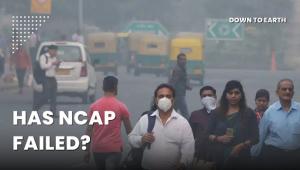
35 Indian cities have recently been listed among the 50 most polluted cities in the world. What's worse, 16 of these cities received nearly Rs 1,000 crore over the past eight years to tackle air pollution. This disturbing finding has placed India’s National Clean Air Programme (NCAP) under intense scrutiny. NCAP is the costliest air pollution control programme ever taken up in India, and one of the biggest globally. But it appears to be non-existent in 19 of the Indian cities that are part of the ‘most polluted’ top 50 list.

Congratulations, PollutionBusters! Grab Your Participation Certificates here.

In 2019, the National Clean Air Programme aimed to reduce particulate pollution—PM2.5 and PM10—by 20-30 per cent by 2024, later raised to 40 per cent by 2026. However, most cities lag behind the 2024 goal despite spending thousands ofcrores, with only eight meeting the target, 22 worsening, and many not even recording continuous data. With high standards on paper but poor implementation in reality, an epic battle against air pollution looms ahead.

Eat Healthy. Breathe Healthy. Stay... ***************************** Zillions of vehicles are emitting a cocktail of poisonous gases. Industries spewing forth more of it. Burning crops, waste dumps on fire, construction and demolition dust, Diwali firecrackers... Winter is here with a host of triggers for a variety of ailments. Add to it, the gastronomic indulgence that the festive season occasions, a time when adulterated food assumes a particularly menacing appearance. The question is, will the Jawan in all of us be able to deal with this double jeopardy?

A snippet of the vibrant activities conducted from the kindergarten tiny-tots to the high-school teenagers under the Green Schools Programme ************************************************************************************** Online education became the talk-of-the-town in 2020 when the entire globe succumbed to an unknown lockdown for more than 300 days. Students became weary and so the entire education community sprung up to the challenge. Country-wide they took to their screens like wildfire, proving their resilience in a jiffy. At the Pawar Public School, Chandivali, we went a step beyond with the Green Schools …

The Yamuna River is the largest tributary of the Ganga. It travels barely a distance of 22 km through Delhi. However, this region contributes to about 80 per cent of its total pollution load. Currently, this stretch discharges waste water from almost 22 drains into the river. Untreated effluents, containing toxins and chemicals, released from houses and industries creates froth (white foam) on the river’s surface. Algae, in addition, prevents sunlight from venturing into the depths of this river. Plus, low water level in the river causes concentration of these pollutants…

To burst or not to burst?’ is a question many young humans might be asking as the patakha (firecracker) season begins. Teachers and doctors tend to advice against firecrackers but there’s always a paan-chewing uncle or a macho friend who’ll bully you kids into becoming enthusiastic arsonists. It’s usually a tough choice to make. Some additional information is always a good help in firming up ones’ resolutions. Therefore, let's throw some light on the history, chemistry, and eco-friendliness of patakhas.

World Health Organization has issued a strong warning about the effects of air pollution on children. On October 29, 2018, it released a report called Air Pollution and Child Health. It states that in 2016, 600,000 children died from acute lower respiratory infections caused by polluted air. What is worse is that 93% of the world's children under the age of 15 (1.8 billion) are exposed to high levels of PM 2.5 which are superfine air pollutants. Worst are those living in developing countries where 98 per cent of all children are exposed to very unhealthy air.

